 Scanning films with suitable settings
Scanning films with suitable settings Removing dust on films
Removing dust on films Reducing grains from the scanning image
Reducing grains from the scanning image Scanning reflective (non-film) documents
Scanning reflective (non-film) documentsUsing Options / Using the Transparency Unit
Scanning films with suitable settings
Removing dust on films
Reducing grains from the scanning image
Scanning reflective (non-film) documents
This section explains how to make settings suitable for materials you want to scan.
Follow the steps below to make settings suitable for scanning films in the Professional Mode.
 | Place your films on the document table. See Setting and Placing Films for details. |
 | Start EPSON Scan and then select the Professional Mode. For details on how to select a scanning mode, see Changing a scanning mode. |
The following window appears.
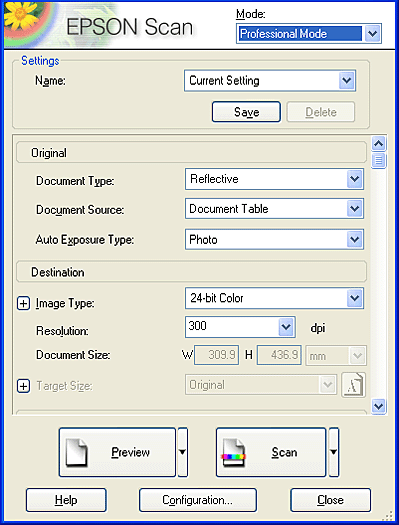
 | Specify the Original settings to match your films. |

|
Document Type |
Film |
|
Film Type |
Select a film type from the Film Type list. |
 | Specify the Destination settings to match the resulting image file you desire. |

|
Image Type |
Select a suitable image type from the Image Type list. |
|
Resolution |
Select a suitable resolution from the Resolution list. |
When you specify a high resolution, the number of pixels of the data increases and the scanned image becomes fine in texture. However, increasing the resolution causes the data size to increase. Specify a suitable resolution according to the scanning purpose.
The following table indicates the suitable resolution to use according to the scanning purpose.
|
Purpose |
Resolution |
|
Sending E-mail |
96 to 150 dpi |
|
Printing |
300 dpi |
|
Filing |
300 dpi |
 | Click the Preview button to preview the images. |
 | Use Target Size to specify the output size of the scanned image and specify the Adjustments settings, if necessary. (You may need to scroll to the bottom of the screen.) |
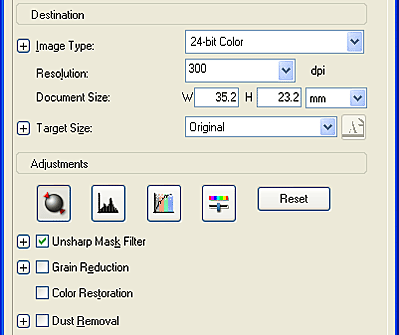
 | You can improve the scanned image quality by removing dust or reducing grains. Follow the instruction on Removing dust on films or Reducing grains from the scanning image. |
 | Click Scan. EPSON Scan starts scanning. |
The scanned images are sent to the application or saved in the specified folder.
You can improve the quality of scanned images by removing dust on films using this feature.
Select the Dust Removal check box. (You may need to scroll to the bottom of the screen.)
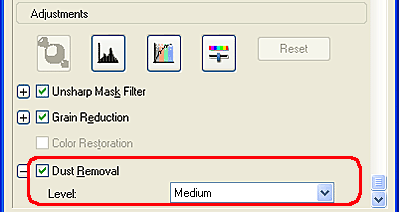
Dust on the films is removed from the scanned images.
|
Dust Removal not applied |
Dust Removal applied |
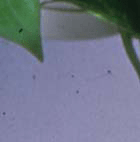 |
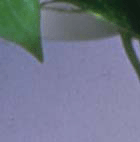 |
| Note: |
|
|
|
You can improve the quality of scanned images by reducing grains. This feature is only available in the Professional Mode.
| Note: |
|
|
 | Select the Grain Reduction check box. (You may need to scroll to the bottom of the screen.) |
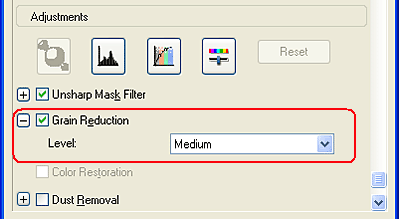
 | Select the level of Grain Reduction from the pull-down list. |
The optical phenomenon where color stripes appear is called Newton's ring. This occurs when two, very thin membranes such as film surfaces or soap bubble surfaces meet.
If this phenomenon occurs, try scanning the film upside down. This may eliminate the effect of Newton's ring.
To scan reflective documents using the Transparency Unit, always insert the reflective document mat included with this unit. Also, make sure you remove the transparency guide from the scanner's document table.
Insert the reflective document mat as described below.
 | Open the Transparency Unit, and then remove the transparency guide from the scanner's document table. |
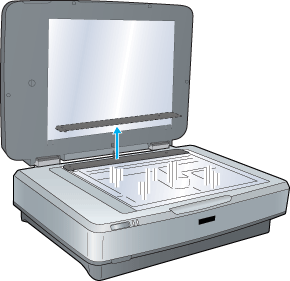
 | Slide the mat into the upper side, and then insert the tabs into the slots on the lower side slots on the Transparency Unit. |
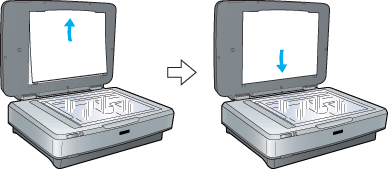
 | Place your document on the document table, and then close the Transparency Unit. |
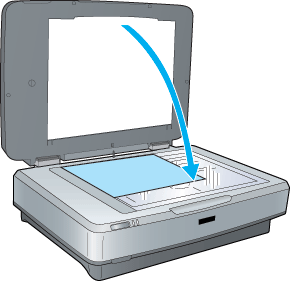
To remove the reflective document mat, slide it up and out of the slots on the Transparency Unit.
 Previous |
 Next |